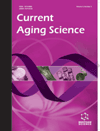- Home
- A-Z Publications
- Current Aging Science
- Previous Issues
- Volume 10, Issue 2, 2017
Current Aging Science - Volume 10, Issue 2, 2017
Volume 10, Issue 2, 2017
-
-
MicroRNAs and Aging: Biomarkers or Therapeutic Targets?
More LessUnderstanding the molecular mechanism of aging is of utmost importance to the scientific communities. To date, various theories have been proposed and many of them were evaluated as potential targets in the battle against aging. MicroRNAs, the universal gene expression regulators, were found to be associated with the aging process as many of them have been linked to biological process associated with cellular dete Read More
-
-
-
Macronutrient Intake and Distribution in the Etiology, Prevention and Treatment of Osteosarcopenic Obesity
More LessAuthors: Owen J. Kelly, Jennifer C. Gilman, Youjin Kim and Jasminka Z. IlichBackground: Osteosarcopenic obesity, the combined deterioration of bone, muscle and fat tissues, could become the ultimate trajectory of aging. Aging stem cells are deregulated by low-grade chronic inflammation and possibly by diet. The metabolic shift of stem cells towards adipogenesis results in osteo obesity, sarco obesity and obesity. Macronutrients have numerous physiological functions but are regarded mainly for th Read More
-
-
-
Can Unconventional Exercise be Helpful in the Treatment, Management and Prevention of Osteosarcopenic Obesity?
More LessAuthors: Owen J. Kelly and Jennifer C. GilmanBackground: Body composition changes occur with aging; bone and muscle mass decrease while fat mass increases. The collective term for these changes is osteosarcopenic obesity. It is known that conventional resistance exercise programs build/maintain lean mass and reduce fat mass. However, unconventional (to Western society/medicine) forms of exercise may be viable for the treatment/prevention of osteosarcopeni Read More
-
-
-
Consciousness, Functional Networks and Delirium Screening
More LessAuthors: Eamonn Eeles, Hana Burianova, Shaun Pandy and Donna PinskerBackground: Consciousness, the medium of sentient thought, requires integrity of functional networks and their connectivity. In health, they function as a co-operative but mutually exclusive paradigm of introspection versus external awareness subserved via the Default Mode Network and Task Positive State, respectively. Higher thinking in the conscious state is then segregated according to need. There is research evid Read More
-
-
-
Factors of Rapid Cognitive Decline in Late Onset Alzheimer's Disease
More LessAuthors: Pierre Koskas, Marie Cecile Henry-Feugeas, Jean-Paul Feugeas, Phalla Ou and Olivier DrunatBackground: Rapid Cognitive Decline (RCD) in Alzheimer's Disease (AD) is associated with a worse disease progression. There is no consensual predictor of RCD and only a few studies have focused on RCD in late-onset dementia, the most common form of AD. Objective: To identify the predictors of RCD, in a population of community-dwelling patients with recently diagnosed late onset AD. Methods: Community-dwelling Read More
-
-
-
Early and Mild Phases of Primary Progressive Aphasia: A Case Series
More LessAuthors: Jessica Powell, James Lendrum, Rosalind Huff, Christine Belden and Marwan N. SabbaghBackground: The early and mild phases of various neurodegenerative diseases, sometimes described as Mild Cognitive Impairment (MCI), has been characterized as the transitional state between normal cognition and dementia. It is described as having cognitive decline not severe enough to cause functional impairment. MCI has been divided into amnestic and non-amnestic subtypes with the amnestic subtype most commonl Read More
-
-
-
In-hospital Falls in Older Patients: The Risk Factors and The Role of Hyponatraemia
More LessAuthors: Harry Harianto and Mahesan AnpalahanBackground: Hyponatraemia has been associated with increased falls risk. However, this has not been adequately investigated in the context of In-Hospital Falls (IHFs). Objectives: To determine the potential risk factors for IHFs, particularly the role of hyponatraemia. Methods: Patients aged >65 years with an incident IHF during admissions under a General Internal Medicine (GIM) Unit over six months were studied. For each case, Read More
-
-
-
Comprehensive Assessment of Compliance with Antimuscarinic Drug Treatment in the Case of Urge Urinary Incontinence of Older Patients
More LessAim: To investigate the heterogeneous factors affecting the stability of patients older than 60 years in the UI treatment with Antimuscarinics. Background: The prevalence of Urge Incontinence (UI) in older persons reaches 29.3%. The symptoms of urinary incontinence in older people reduce the health related life quality. Materials and Methods: In 1257 patients over 60 years (857 (68.2%) women - average age 67.8, 40 Read More
-
Volumes & issues
Most Read This Month
Article
content/journals/cas
Journal
10
5
false
en

Most Cited Most Cited RSS feed
-
-
Polyphenols and Aging
Authors: Brannon L. Queen and Trygve O. Tollefsbol
-
- More Less

